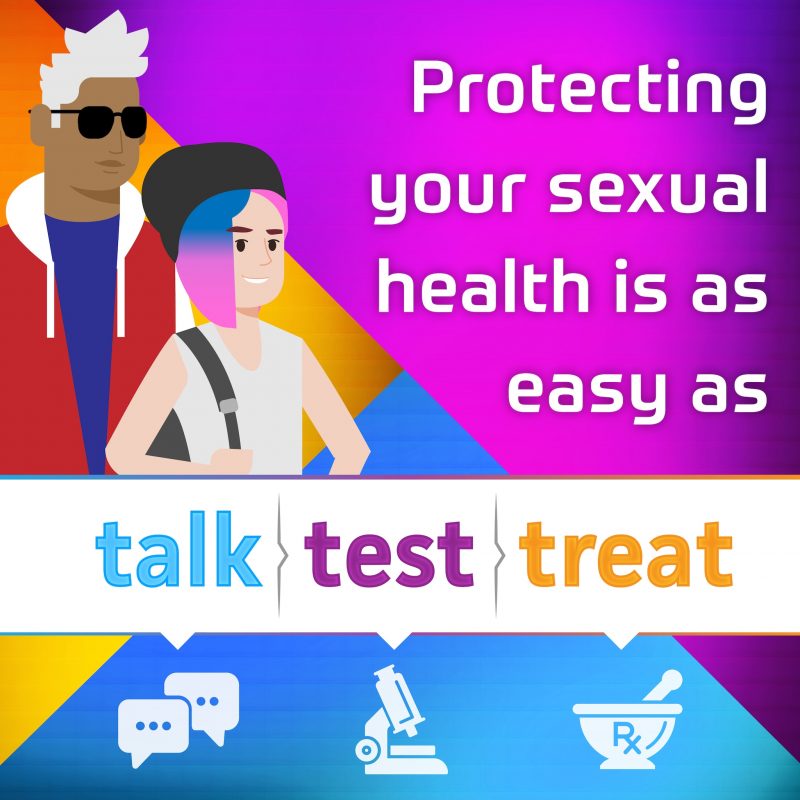
April is
STI Awareness month
This April, in honor of STI Awareness Month, take some time to learn about sexually transmitted infections (STIs). Anyone who is sexually active can get an STI, so why not learn more about them and how to minimize your exposure to STIs and take care of your sexual health.
The Centers for Disease Control and Prevention (CDC) marks its own STI Awareness Week in April with the theme Talk, Test, Treat. It’s a good framework to think about STIs and your sexual health. Let’s start with talk—there’s a lot to talk about!
Let's Talk
and not just about sex (but yes, also about sex).
Talking openly and honestly about sex and sexual health makes for relationships that are more fun and satisfying. STIs are one part of that talk—when you were last tested for STIs, which ones, and what the results were. You can also talk about how often you get tested and whether you’ve had any partners since your last test. Having an open and honest conversation about STIs before you become sexually intimate is ideal.
But there’s so much more to talk about! What safer sex precautions do you want to take? Are you interested in a monogamous relationship or not? What gets you excited? What kind of touch do you like…and what do you not like. On that note, what are your boundaries?
Sounds like a lot, doesn’t it? Where do you even begin? What if you want to talk about a positive STI diagnosis? How do you bring up the topic of pleasure? Evalene Dacker, MD, is a physician and sexual health educator who has created a great model that helps guide the conversation—the STARS Model. STARS is an acronym that stands for : Sexual Health and STI Status, Turn-Ons, Avoids, Relationship Intentions and Expectations, and Safety Needs and Safer Sex Etiquette.
In this interview, Dr. Dacker describes the STARS model and does roles plays showing how real life conversations about STIs would go, including discussions of testing status and talking to a partner about a positive diagnosis for herpes. Like ASHA, Dr. Dacker believes we should destigmatize conversations around sex, sexual health, and STIs. As she says, “The worst STIs that we give each other are shame, guilt, and fear.”
Getting Tested
There have never more ways to get tested
You might think you’d know that you have an STI, because you’d have some kind of sign or symptom that something was wrong. That’s true sometimes—STIs can cause symptoms like itching or burning or sores or discharge. But many times, probably much more often than you think, there are no symptoms at all. STIs can be “silent.” That’s why the term STI is more frequently used than STD, or sexually transmitted disease. You can be infected with an STI but have no symptoms of disease.
That’s where testing comes in. The only reliable way to know if you have an STI is to get tested.
But what tests do you need? And how often should you be tested? There are some general guidelines—for example, the CDC recommends that all sexually active people assigned female at birth ages 15-24 should be tested for gonorrhea and chlamydia every year. These infections are common among this population, and untreated gonorrhea and chlamydia infections can cause serious health complications like infertility (the inability to conceive or carry a pregnancy).
Testing can be simple, like a urine sample or swab test. You can get tested at your provider’s office, an STI clinic, or even some pharmacy and retail locations. There are also options to test at home—some that allow you to test and get results shortly after, and others where you collect your own sample and mail that in to a laboratory.
Our downloadable fact sheet helps explain the variety of different STI testing options, including home testing, self-collection, point-of-care testing, and testing with a health care provider.
STI Treatment
Here’s the good news—many STIs are curable and all STIs are treatable. There are some STIs—like chlamydia or trichomoniasis—that can be treated and cured with antibiotics. Viral STIs like herpes and HIV can’t be easily cured with medication, but they can be treated. Treatment for these infections can also help reduce the possibility of transmitting the infection on to a partner.
If there is any bad news it’s this—treatment can cure or treat infections, but it can’t help with any health problems that might develop before the infection is treated. For example, if chlamydia goes undiscovered and untreated in a person with a uterus, it can lead to a condition called pelvic inflammatory disease (PID), a serious infection the uterus, fallopian tubes and ovaries. PID can lead to infertility the inability to become pregnant or maintain a pregnancy), chronic pelvic pain, or ectopic pregnancy. In someone with a penis, untreated chlamydia can lead to prostatitis (inflammation of the prostate gland), scarring of the urethra, or infertility.
The takeaway is clearly that it’s best to discover and treat any infections as early as possible, to avoid any other health issues. This is why regular testing is so important if you’re sexually active.
